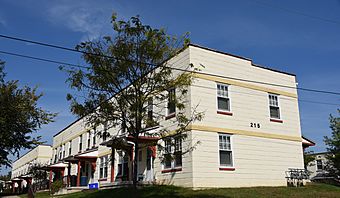Fairbanks Flats facts for kids
Quick facts for kids |
|
|
Fairbanks Flats
|
|
 |
|
| Location | Beloit, Wisconsin |
|---|---|
| Built | 1917 |
| NRHP reference No. | 83003416 |
| Added to NRHP | January 7, 1983 |
The Fairbanks Flats are four apartment buildings located in Beloit, Wisconsin. They were built in 1917 by the company Fairbanks Morse. The company built these apartments to provide homes for their black workers who were moving from the southern parts of the United States. While these buildings kept black families living together, they also helped create the center of Beloit's black community. In 1983, the Fairbanks Flats were added to the National Register of Historic Places, recognizing their historical importance.
Contents
History of the Fairbanks Flats
Why the Flats Were Built
At the start of World War I, Fairbanks-Morse was the largest employer in Beloit. The company made engines. In 1914, they began making a new type of engine for ships. This meant they needed many more workers.
To find enough people for these jobs, Fairbanks-Morse hired black factory workers. Many of these workers came from the Southern United States. In the South at that time, laws known as "Jim Crow laws" kept black and white people separate. Six families arrived in 1915. By 1917, about 250 families had moved to Beloit to work for Fairbanks-Morse. Many were new to factory work, but some were skilled workers like blacksmiths and molders.
Solving the Housing Shortage
The large number of new workers caused a housing shortage in Beloit. Fairbanks-Morse decided to help solve this problem. A part of their company, Eclipse Home Makers, Inc., bought land where the Fairbanks Flats now stand. This land was on the west side of the Rock River, across from the factory.
The company planned to build simple apartments there. Their goal was to house "the large number of negroes in one place" on what was then the edge of town. At the same time, Fairbanks-Morse was planning a separate housing area for its white employees. This area, called Eclipse Park, would have single-family homes and curved streets. It was designed by a famous architect named George B. Post.
A City Controversy
Keeping people of different races separate, known as segregation, was not a big public concern at the time. However, the land purchase for Fairbanks Flats did cause a problem. Fairbanks-Morse bought the land just before the city planned to get it for a new city park and boulevard system. Many people felt this land was very important for the park system.
The city even threatened to take the land to stop the deal. The mayor of Beloit warned that the project could create "class bitterness" that would last for many years. Despite these concerns, Fairbanks-Morse went ahead with its building project.
Building the Apartments
Construction of the Fairbanks Flats began in late 1917. Four apartment blocks were built. Each block contained six apartments, with two stories each. The buildings were made of concrete blocks. They had shed roofs and parapets (low walls) on top of the side walls.
The front middle of each building has double doors, protected by a small canopy. A simple band of blocks sticks out, connecting the tops of the windows on each floor. Other than this, the buildings have very little decoration.
Life at the Flats
In the years that followed, Fairbanks-Morse brought in J.D. Stevenson from Tuskegee Institute. He helped start a YMCA (Young Men's Christian Association) nearby for black youths. The apartments eventually became known as the Edgewater Flats. Fairbanks-Morse officials continued to manage them until at least 1929.
After World War II, the ownership of the Flats changed. People who did not work for Fairbanks-Morse could then rent apartments there. Even so, the Flats remained mostly home to black families. The reason the Flats are considered historically important is because they show how private companies helped plan communities during a time of fast industrial growth. They are also important as the starting point for Beloit's black community in the 20th century.



